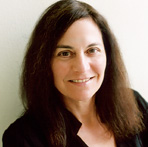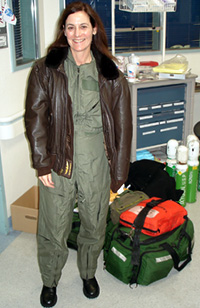SFGH Surgeon: Helping the Wounded in Germany

Peggy Knudson
Peggy Knudson, MD, San Francisco General Hospital trauma surgeon of 18 years, has been selected for a second time to work at the Landstuhl Regional Medical Center, as part of the Senior Visiting Surgeon Program funded jointly by the American Association for the Surgery of Trauma, the American College of Surgeons and the US military. Landstuhl, located near the French border in Germany, started as a small Army hospital in 1953, and is now the largest American hospital outside of the United States. Although Landstuhl is one of the most advanced military hospitals in the world, its trauma surgeons need training and support to accommodate an average of 75 wounded soldiers that are airlifted from the battlefields of Iraq every week. Knudson was one of 12 trauma surgeons selected from more than 25 applicants for this program, which started accepting applications in July 2006. The 12 surgeons will work at Landstuhl for a two- to four-week period at different times from July 2006 to the end of 2007. Knudson, who was the only surgeon selected from UCSF, serves on the board of managers of the American Association for the Surgery of Trauma and is vice chair of the American College of Surgeons Committee on Trauma. She has also been the principal investigator of the Centers for Disease Control and Prevention (CDC)-sponsored San Francisco Injury Center since 1994. During her first stint at Landstuhl, Knudson worked alongside the military surgeons in the operating room and in the intensive care unit, serving as a senior consultant integrating civilian trauma surgical treatment protocols with those of the military surgeons. "I got over there and I was just fascinated. You see these young guys who are serving their country and they have so much spirit. The doctors and nurses are so dedicated and they really pull together. Having worked in civilian medicine for so long, this experience was very rewarding," said Knudson of her first trip to Landstuhl in December 2006. "With this visiting surgeon program, we are helping to provide support for the hard-working military trauma surgeons during wartime, and in return, they will be available to help us in peacetime." During her 17-day service in December, Knudson trained Landstuhl physicians in the use of portable SonoSite ultrasound machines, which can be used to quickly detect injuries in field hospitals where diagnostic X-ray studies are limited. These small units can also be used on rounds in the intensive care unit to detect post-injury complications such as recurrent bleeding, pneumothorax and venous thrombosis. Venous thrombosis, a potentially lethal complication, commonly occurs after injury, especially after prolonged aeromedical evacuations, which occur daily from Iraq or Afghanistan. As part of a $5 million grant from the CDC, Knudson is researching the association between injury and blood clotting. And since clotting is a factor in plane transportation, even among noninjured people, Knudson is training military physicians to check for clotting before moving critical patients onto planes. She is also analyzing the risks and benefits of a new medication, activated Factor VIIa, which is being utilized by military surgeons to control bleeding, but which may carry its own consequences. She and other members of the senior visiting surgeons group are preparing a scientific review article on their findings for the New England Journal of Medicine. "The air transport of critical patients is a whole new branch of medicine for me, and I have a lot to learn from them," said Knudson. "There are all kinds of physiologic considerations that come in to play when sick patients are taken into the air, especially when they will be up there for the 12-hour flight from Germany to the United States."
 |
|
Knudson at Landstuhl. |
At Ramstein Air Base, Knudson greeted wounded soldiers where C-17 aircraft manned with Critical Care Air Transport (CCAT) teams arrived from Iraq (Operation Iraqi Freedom) or Afghanistan (Operation Enduring Freedom). Typically, injured soldiers are evacuated to Landstuhl within 24 to 48 hours from the time of injury. The plane trip from Iraq to Landstuhl is eight hours, so receiving physicians have time to review the patients' computerized medical records and to prepare for and initiate treatment upon arrival. Most planes carry 30 patients, with five to seven being critically injured. "When I was at the landing site, the whole production was like a ballet. Patients were loaded and unloaded while a physician, respiratory technician and two nurses stayed at the bedside of each critically injured patient, just as if the patient was in an ICU bed," said Knudson. "The professionalism of these critical care teams was just amazing." Most of the soldiers return to active duty after a two-week stay at Landstuhl. But if their injuries are too critical for combat, soldiers are flown back to the United States within days of injury to Walter Reed Army Medical Center in Washington DC, National Naval Medical Center in Bethesda, Maryland, or the Brooke Army Medical Center burn unit in Fort Sam Houston, Texas, for the remainder of their care. With reverence for her Landstuhl experience, she keeps four heavy, decorative, medallion-like coins in her office at San Francisco General Hospital. Each coin was a gift to express gratitude for her service. "This one is for hospital service at Landstuhl, this one is from the American ambassador to Germany, and this one is from the Balad Air Base CCAT team," said Knudson, displaying the coins one by one. "This last one is from the commander of the Army Central Command, Abizaid, and the only two people who can give out coins higher than this one are Robert Gates and President Bush. So I feel very honored to have received this gift." For her second trip in June, Knudson will be one of three surgeons evaluating whether or not Landstuhl meets the criteria to become a "verified" trauma center, as defined by the American College of Surgeons Committee on Trauma. This is the first time these standards will be employed by a medical facility outside the United States or by any strictly military medical facility in the world. In June, Knudson also hopes to ride with the CCAT teams and to evaluate both the aircraft that are equipped, similarly to an ambulance, for emergency care, and the hospital in Balad, Iraq. "I'm looking forward to going back. I've learned so much and this is one of the best experiences I've ever had," said Knudson. "You see these soldiers who will be deformed for a long time and still, they are so positive. It makes me think, 'Why are we doing this to these kids?' But whether you're a deployed military surgeon or a volunteer civilian trauma surgeon, the important thing is to do your job well and offer these wounded soldiers the best chance of recovery."
Related links:
Three Receive Global Health Sciences Research Awards UCSF Today, July 26, 2006
San Francisco General Hospital Medical Center